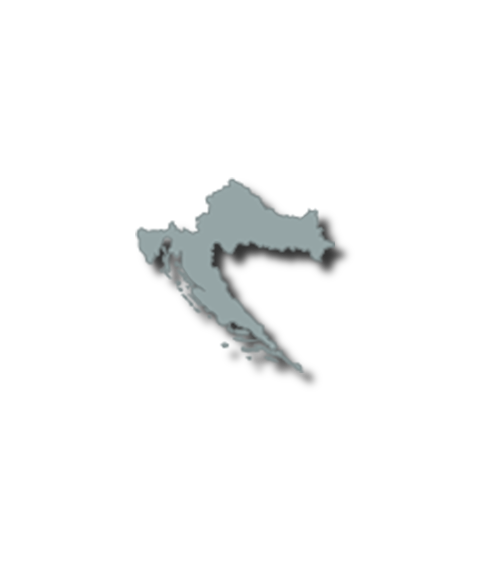Croatia |
|
|
Select by country / Croatia |
| Capital: |
Zagreb |
|
 |
| Population: |
4.06 Million |
| GDP per capita: |
€ 29.1 Thousand |
| |
| National Film Fund: |
No |
| Regional Film Funds: |
No |
| |
| National Film Commission: |
No |
| Incentive: |
No |
| |
Croatia is in Central and Southeast Europe, on the coast of the Adriatic Sea. It borders Hungary to the northeast, Serbia to the east, Bosnia and Herzegovina and Montenegro to the southeast and Slovenia to the northwest. It lies mostly between latitudes 42° and 47° N and longitudes 13° and 20° E. Part of the territory in the extreme south surrounding Dubrovnik is a practical exclave connected to the rest of the mainland by territorial waters, but separated on land by a short coastline strip belonging to Bosnia and Herzegovina around Neum. The Pelješac Bridge, scheduled to open in 2022, will connect the exclave with the mainland Croatia.
The territory covers 56,594 square kilometres (21,851 square miles), consisting of 56,414 square kilometres (21,782 square miles) of land and 128 square kilometres (49 square miles) of water. It is the 127th largest country in the world. Elevation ranges from the mountains of the Dinaric Alps with the highest point of the Dinara peak at 1,831 metres (6,007 feet) near the border with Bosnia and Herzegovina in the south to the shore of the Adriatic Sea which makes up its entire southwest border. Insular Croatia consists of over a thousand islands and islets varying in size, 48 of which permanently inhabited. The largest islands are Cres and Krk, each of them having an area of around 405 square kilometres (156 square miles).
The hilly northern parts of Hrvatsko Zagorje and the flat plains of Slavonia in the east which is part of the Pannonian Basin are traversed by major rivers such as Danube, Drava, Kupa, and the Sava. The Danube, Europe's second-longest river, runs through the city of Vukovar in the extreme east and forms part of the border with Vojvodina. The central and southern regions near the Adriatic coastline and islands consist of low mountains and forested highlands. Natural resources found in the country in quantities significant enough for production include oil, coal, bauxite, low-grade iron ore, calcium, gypsum, natural asphalt, silica, mica, clays, salt, and hydropower. Karst topography makes up about half of Croatia and is especially prominent in the Dinaric Alps. There are several deep caves in Croatia, 49 of which deeper than 250 m (820.21 ft), 14 of them deeper than 500 m (1,640.42 ft) and three deeper than 1,000 m (3,280.84 ft). Croatia's most famous lakes are the Plitvice lakes, a system of 16 lakes with waterfalls connecting them over dolomite and limestone cascades. The lakes are renowned for their distinctive colours, ranging from turquoise to mint green, grey or blue.
|
Croatia
GDP per capita:
€ 29.1 Thousand
National Film Commission:
No
Croatia is in Central and Southeast Europe, on the coast of the Adriatic Sea. It borders Hungary to the northeast, Serbia to the east, Bosnia and Herzegovina and Montenegro to the southeast and Slovenia to the northwest. It lies mostly between latitudes 42° and 47° N and longitudes 13° and 20° E. Part of the territory in the extreme south surrounding Dubrovnik is a practical exclave connected to the rest of the mainland by territorial waters, but separated on land by a short coastline strip belonging to Bosnia and Herzegovina around Neum. The Pelješac Bridge, scheduled to open in 2022, will connect the exclave with the mainland Croatia.
The territory covers 56,594 square kilometres (21,851 square miles), consisting of 56,414 square kilometres (21,782 square miles) of land and 128 square kilometres (49 square miles) of water. It is the 127th largest country in the world. Elevation ranges from the mountains of the Dinaric Alps with the highest point of the Dinara peak at 1,831 metres (6,007 feet) near the border with Bosnia and Herzegovina in the south to the shore of the Adriatic Sea which makes up its entire southwest border. Insular Croatia consists of over a thousand islands and islets varying in size, 48 of which permanently inhabited. The largest islands are Cres and Krk, each of them having an area of around 405 square kilometres (156 square miles).
The hilly northern parts of Hrvatsko Zagorje and the flat plains of Slavonia in the east which is part of the Pannonian Basin are traversed by major rivers such as Danube, Drava, Kupa, and the Sava. The Danube, Europe's second-longest river, runs through the city of Vukovar in the extreme east and forms part of the border with Vojvodina. The central and southern regions near the Adriatic coastline and islands consist of low mountains and forested highlands. Natural resources found in the country in quantities significant enough for production include oil, coal, bauxite, low-grade iron ore, calcium, gypsum, natural asphalt, silica, mica, clays, salt, and hydropower. Karst topography makes up about half of Croatia and is especially prominent in the Dinaric Alps. There are several deep caves in Croatia, 49 of which deeper than 250 m (820.21 ft), 14 of them deeper than 500 m (1,640.42 ft) and three deeper than 1,000 m (3,280.84 ft). Croatia's most famous lakes are the Plitvice lakes, a system of 16 lakes with waterfalls connecting them over dolomite and limestone cascades. The lakes are renowned for their distinctive colours, ranging from turquoise to mint green, grey or blue.

